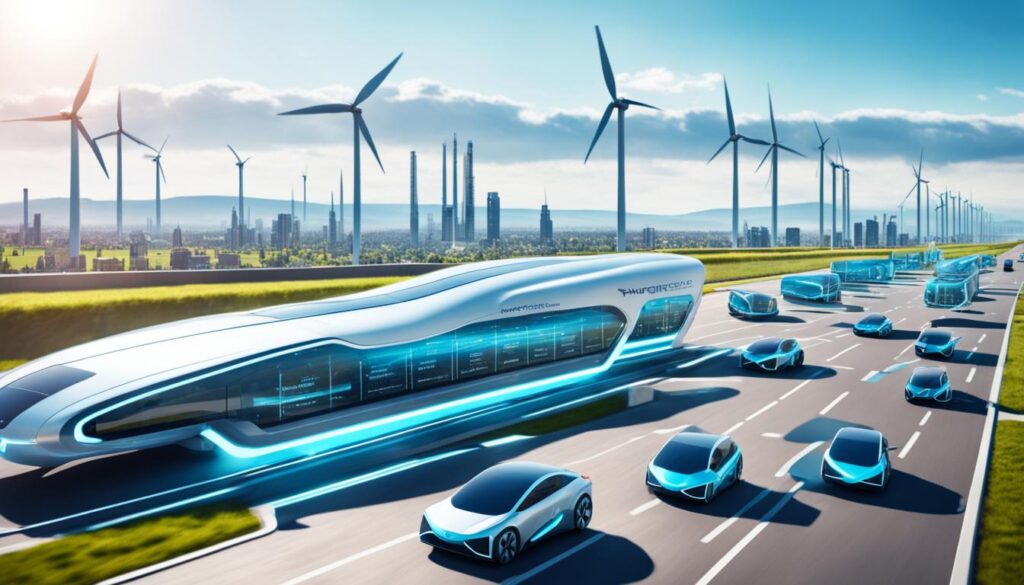The world is looking for ways to cut down on greenhouse gas emissions and fight climate change. Hydrogen is becoming a key player in this effort. It’s the most common element in the universe and can be made from renewable energy1.
Since 1975, the need for hydrogen has tripled. Now, 6% of the world’s natural gas and 2% of its coal goes into making hydrogen1. But, making hydrogen now releases about 830 million tonnes of carbon dioxide a year. This is as much as the UK and Indonesia combined1. So, there’s a big push to find cleaner ways to make hydrogen, with over 50 countries supporting this effort, especially in transport1.
Hydrogen can be made from many sources, like renewables, nuclear, and more. This makes it a flexible energy option1. It can also store energy from things like solar and wind power. This means it can provide steady and dependable energy1.
Key Takeaways
- Hydrogen is a versatile energy carrier that can be produced from renewable sources, offering a clean energy solution.
- The demand for hydrogen has grown significantly, with increasing global efforts to support its adoption, particularly in the transportation sector.
- Hydrogen production from fossil fuels currently accounts for a significant portion of global carbon emissions, highlighting the need for a shift towards cleaner production methods.
- Hydrogen has the potential to store excess renewable energy, contributing to a more resilient and reliable energy system.
- Overcoming the higher production costs and infrastructure challenges of hydrogen will be crucial for its widespread adoption as a clean energy solution.
What is Hydrogen?
Hydrogen (H) is the first element on the periodic table and the simplest and lightest molecule in the universe2. It’s a unique energy source that is colorless, odorless, and tasteless2. When burned with oxygen, it only makes water, making it a clean fuel with no carbon emissions2. It also has more than double the energy of natural gas, showing its potential as a strong energy carrier2.
Even though hydrogen is common in the universe, it’s not found freely on Earth and must be made from other sources3. Most of it, about 95%, is made through the steam reforming of natural gas, with the rest from electrolysis2. Using renewable power like solar and wind to make hydrogen makes it a clean energy choice2.
Hydrogen Production Methods
There are many ways to make hydrogen, each with its own pros and cons. Some top methods include:
- Steam methane reformation: This is the main way, making most of the world’s hydrogen3.
- Electrolysis: Using renewable power like solar and wind to split water and get hydrogen2.
- Biological processes: Microbes can turn organic matter into hydrogen2.
- Solar-driven processes: These use the sun’s energy through photobiological, photoelectrochemical, and solar thermochemical methods2.
As we move towards a sustainable future, making hydrogen from renewable sources is key2. This change can cut down the carbon emissions from making hydrogen2.
“Hydrogen as a gas is less than one part per million by volume in the atmosphere, making it a scarce resource that must be produced.”3
To use hydrogen as an alternative to fossil fuels, it needs to be made on a large scale, affordably, and with the right infrastructure3. Using hydrogen as an energy source is promising, but there are big challenges in making, storing, and getting it to people4.
Current Hydrogen Production Methods
Hydrogen is made in many ways, each with its own effect on the environment. In the U.S., the main ways to make hydrogen are through natural gas reforming, coal gasification, and water electrolysis.
Natural Gas Reforming
Most hydrogen in the U.S. comes from natural gas reforming with steam5. This method, called steam-methane reforming, is the top choice because it’s cheap, efficient, and common5. It mixes high-temperature steam and methane to make hydrogen, carbon monoxide, and a bit of carbon dioxide6. Natural gas, the main source of methane, is easy to get and used by many industries for making hydrogen6.
Coal Gasification
Coal gasification is another way to make hydrogen, known as “brown” or “black” hydrogen. It turns coal into synthesis gas, a mix of hydrogen, carbon monoxide, and other gases, with high-temperature reactions and oxygen and steam.
Water Electrolysis
Water electrolysis makes hydrogen by splitting water with an electric current5. This “green” method is getting more popular because it uses extra renewable electricity from sources like solar, wind, and hydropower to make clean hydrogen57.
The U.S. doesn’t use a color system for hydrogen, but other countries do. “Gray” hydrogen comes from natural gas without capturing carbon, while “blue” hydrogen is made with carbon capture and storage. “Pink” hydrogen is a nuclear power byproduct6.
The U.S. Department of Energy is working on making clean hydrogen cheaper and wants to cut the cost by 80% to $1 per 1 kg in 10 years6. This is part of the National Clean Hydrogen Strategy and Roadmap, aiming to improve clean hydrogen tech and meet laws6.
| Hydrogen Production Method | Description | Environmental Impact |
|---|---|---|
| Natural Gas Reforming | The most common method, using high-temperature steam to react with methane | Produces CO2 emissions, but less than other fossil fuel-based methods |
| Coal Gasification | Converts coal into synthesis gas, a mixture of hydrogen, CO, and other byproducts | Results in significant CO2 emissions and other pollutants |
| Water Electrolysis | Uses an electric current to split water into hydrogen and oxygen | Produces no emissions when powered by renewable energy sources |
“The U.S. Department of Energy aims to reduce the cost of clean hydrogen production by 80% to $1 per 1 kg in 1 decade.”
hydrogen from renewable power: Potential Energy Carrier
Hydrogen doesn’t exist naturally but can be made from other energy sources like water8. It’s a key energy carrier that can travel worldwide and power things, making it a great way to store energy8. This makes it a big part of the move to clean energy.
There are many ways to make hydrogen from renewable energy, like using solar or wind power8. Figure 6 shows that making green hydrogen is still growing but has a lot of potential8. This means we can expect to see more progress and lower costs in making green hydrogen.
Hydrogen can be stored and moved easily, either as a liquid or gas8. Figure 16 shows it can work well with our current gas infrastructure, making it even more useful8. Plus, it’s great for storing energy for a long time, helping fix the problem of renewable energy being not always available8.
Hydrogen is very versatile and could be a big part of our energy future8. By 2050, it might make up a big part of our energy use, especially in industries and transport8. This shows how important hydrogen could be in making industries and transport cleaner.
Overall, making hydrogen from renewable sources and its ability to be moved and stored make it a promising energy carrier8. As technology gets better and costs go down, hydrogen will likely play a big role in our clean energy future8.
Hydrogen Production from Water
Electrolysis is a main way to make hydrogen, turning water into oxygen and hydrogen9. Using renewable energy like solar or wind makes it “green hydrogen”9. This is a clean way to get this important energy carrier.
But electrolysis isn’t the only way to make hydrogen from water9. Microbes can do it too, and sunlight can be used in different ways to make hydrogen9. These methods offer many ways to use renewable energy to make clean hydrogen.
Hydrogen as an Energy Carrier
Hydrogen is great for moving and storing energy for many uses, like making power, moving vehicles, and industrial processes9. Its high energy density and ability to be compressed or liquefied make it easy to transport and store9.
Using hydrogen in fuel cells can cut down on emissions a lot9. For cars, this can mean over 90% less emissions, and buses can use more fuel efficiently9. This shows how hydrogen could help make transport cleaner.
Even with challenges in storing and moving hydrogen, and the cost of fuel cells, its benefits are clear9. As technology gets better and costs drop, hydrogen will likely play a big part in our energy future9.
Hydrogen Production Pathways
There are different ways to make hydrogen, each with its own effects on the environment and costs10. Most hydrogen now is “grey hydrogen” from natural gas, which is bad for the environment10.
“Blue hydrogen” is made with technology to capture and store carbon, making it better for the planet10. “Green hydrogen” is the cleanest option, made from renewable energy, but it’s still more expensive10.
“Pink hydrogen” is made with nuclear power, which is low-carbon, but its sustainability depends on the nuclear power and waste handling10.
Hydrogen’s versatility as an energy carrier is clear10. It can be used in fuel cells, stored for renewable energy, and made into chemicals and fuels10. Making more green hydrogen will be key to a sustainable energy future10.
Applications of Hydrogen Energy
Hydrogen has many uses that help reduce carbon emissions in different areas11. Most of the hydrogen used in the U.S. goes to industries for refining oil, treating metals, making fertilizer, and processing food11. Refineries use it to cut down sulfur in fuels11. Biofuel makers use it to create a renewable diesel called HVO11.
Hydrogen for Transportation
Hydrogen powers fuel cell electric vehicles (FCEVs), offering a clean choice over traditional cars11. By March 2024, the U.S. had about 210 fuel cell electric power generators at 151 sites, with a total capacity of 384 megawatts11. But in 2022, fuel cells only made less than 1% of the U.S.’s electricity11. The country has around 60 hydrogen stations, all in California11.
Hydrogen for Heating and Electricity Generation
Hydrogen can warm buildings and make electricity. Some U.S. power plants plan to use a mix of natural gas and hydrogen in their turbines, like the Long Ridge project in Ohio11. NASA has the biggest liquid hydrogen tanks, showing hydrogen’s potential in storing energy11. The Advanced Clean Energy Storage project in Utah aims to store large amounts of renewable hydrogen for long-term energy use11.
Hydrogen for Industrial Processes
Hydrogen is also used in many industrial processes11. It helps make ammonia and steel, among other things12. It’s seen as a clean option for industries like steel and cement making12.
Hydrogen can help cut emissions in hard-to-decarbonize sectors12. But, we must think about how making hydrogen affects the environment12. Billions of dollars are being invested in hydrogen tech, making green and blue hydrogen key for a sustainable future1213.

“Hydrogen has the potential to play a significant role in decarbonizing sectors where reducing emissions is particularly challenging.”
Environmental Benefits of Hydrogen
Using hydrogen as an energy source has big environmental benefits. When burned, it only makes water, with no carbon dioxide emissions14. This makes hydrogen a clean fuel that can cut down on air pollution and greenhouse gas emissions compared to fossil fuels14. Plus, making hydrogen from renewable sources like water makes it even better for the planet, making it a key part of a sustainable energy future15.
Hydrogen can greatly help clean up the transportation sector, which uses a lot of energy and emits a lot of pollution14. Right now, transportation is responsible for about one-third of U.S. carbon dioxide emissions14. Using hydrogen-powered vehicles could cut those emissions way down14. Plus, these vehicles could go over 300 miles on a single fill-up14, making them a good alternative to traditional cars.
Hydrogen’s benefits aren’t just for cars. It can also be used in industrial processes like making ammonia and steel, where cutting emissions is hard15. Making “green” hydrogen from water with renewable energy can make producing hydrogen much cleaner than the usual way, which releases a lot of CO215.
| Hydrogen Production Method | Emissions Impact |
|---|---|
| Green Hydrogen (renewable energy-based) | Significantly lower emissions compared to conventional methods |
| Blue Hydrogen (natural gas with carbon capture) | Lower emissions than gray hydrogen, but higher than green hydrogen |
| Gray Hydrogen (natural gas without carbon capture) | Significant emissions, comparable to other fossil fuels |
As we move towards a sustainable future, hydrogen’s benefits make it a strong choice for cutting down on greenhouse gases and tackling climate change16.
“Replacing all grey hydrogen production with green hydrogen would require 3,000 TWh/year from new renewables, equivalent to the current energy demand of Europe.”16
Challenges of Adopting Hydrogen Energy
Hydrogen is seen as a clean energy source, but it faces big hurdles for wider use. The main issues are high production costs, needing more renewable energy for making hydrogen, and changing infrastructure for transport and storage17.
Production Costs and Renewable Energy
Producing green hydrogen costs about $3 to $6 per kilogram. Technology improvements could make it cheaper17. But, only about 5% of hydrogen is made from renewable energy, with most coming from fossil fuels18. Switching to renewable energy for making hydrogen is key for the environment, but it will take a lot of investment and changes to infrastructure19.
Infrastructure Challenges
Hydrogen is the most energy-rich fuel, so we need good storage and transport methods17. There are different ways to store hydrogen, like compressed gas, liquid, and solid-state storage for better safety17. Transporting it requires special equipment and tanks because it’s so light17. Fixing these infrastructure issues is key for hydrogen to become a main energy source.
Also, not many electrolyzers are used for making green hydrogen yet. Most are in industries like making chlorine, semiconductors, and power19. We need more electrolyzers and cheaper ones to grow the hydrogen economy.

Overcoming the challenges of hydrogen energy needs a plan from both the public and private sectors. This plan should focus on tech improvements, building infrastructure, and policy support to use hydrogen as a clean energy source19.
Hydrogen Economy
The idea of a “hydrogen economy” pictures a future where hydrogen is key in the global energy mix, replacing fossil fuels20. In this future, hydrogen will come from renewable sources like wind and solar. It will be used in transport, industry, and power generation. Switching to a hydrogen economy could cut down on greenhouse gas emissions a lot, helping meet global climate goals.
Now, most hydrogen in the U.S., about 95%, comes from natural gas reforming in big plants20. But, new ways using renewable energy are coming up. These include biomass gasification, solar thermochemical hydrogen, and wind-powered water electrolysis20. These methods could make the hydrogen economy cleaner.
One big challenge is that making hydrogen is still more expensive than making fossil fuels21. Natural gas-based hydrogen costs about $1.50 per kg, while clean hydrogen from renewables is around $5 per kg21. But, the U.S. Department of Energy wants to cut clean hydrogen costs to $1 per kg in ten years with better technology21.
Even with high costs, hydrogen is versatile and key for cutting emissions in hard-to-decarbonize areas like heavy transport21. It’s called the “Swiss Army knife of energy” because of its huge potential to change the global energy scene and push for a cleaner future.
| Hydrogen Production Method | Energy Source | Carbon Emissions |
|---|---|---|
| Gray Hydrogen | Natural Gas | High |
| Blue Hydrogen | Natural Gas with Carbon Capture | Low |
| Green Hydrogen | Renewable Energy (Wind, Solar, Hydropower) | Zero |
| Pink Hydrogen | Nuclear Energy | Zero |
The table shows the different types of hydrogen production, highlighting the need for cleaner sources for a sustainable future21. Gray hydrogen has high emissions, but blue and green hydrogen offer much lower or no emissions21.
“Hydrogen may grow into a multitrillion-dollar global market, potentially dominating the energy industry.”21
The hydrogen economy looks like a promising way to cut down on greenhouse gas emissions and fight climate change. With new tech, policy support, and better infrastructure, it could change how we make, store, and use energy. This could lead to a cleaner and more sustainable future.
Policy Support for Hydrogen Technologies
Governments worldwide see the big potential in hydrogen tech and are backing it with policies22. These efforts are key to boosting investment, research, and infrastructure for a clean energy future23.
In the U.S., the National Clean Hydrogen Strategy looks at how to produce, transport, store, and use hydrogen by 2030, 2040, and 205023. The Clean Hydrogen Production Standard was set to meet the 2021 Infrastructure Investment and Jobs Act23. Laws like the Energy Independence and Security Act of 2007 and the Energy Policy Act of 2005 and 1992 also pushed for hydrogen research and development23.
Even with these efforts, hydrogen still lacks strong legislative support, holding back its full potential24. The current incentives are small and mainly for research and early projects, with little help for operational costs24. Also, renewable hydrogen is likely to be pricier than traditional hydrogen, showing the need for more financial backing24.
To make the most of hydrogen tech, policymakers need to tackle cost, technical, demand, and carbon leakage issues22. Using green hydrogen in sectors like industry can help speed up its adoption and support a sustainable future22.
As hydrogen gains more support, it’s vital for governments to work together and create strong policies to push this tech forward22. With the right support, hydrogen can be key in cutting emissions and securing a sustainable energy future23.
Hydrogen for Energy Storage
Hydrogen is becoming a key player in energy storage, helping to reduce carbon emissions. It can turn excess renewable energy into stored hydrogen through electrolysis25. This means no renewable energy will go to waste, as it can be stored for later use25.
In California, the “Duck Curve” shows how solar energy is plentiful during low-demand times but scarce during peak evening hours25. The U.S. lacks enough battery capacity to store clean energy for peak demand times25. Hydrogen could be the answer, storing large amounts of clean energy for later use25.
Using electrolysis, hydrogen can store clean energy from renewable sources25. Salt caverns are a top choice for storing liquefied hydrogen economically25. Regions like the southern and Midwest U.S. are set to lead in early hydrogen storage projects25. Hydrogen is also a good option for storing energy seasonally, especially in winter when solar power is scarce25.
Hydrogen isn’t just for storage; it can also carry energy. Over 85% of low-carbon hydrogen projects use ammonia and hydrogen for domestic and export markets26. Ammonia is easier to store and transport than hydrogen because it has more energy density26. Hydrogen can also be stored in metal hydrides like palladium, absorbing 900 times its own volume26.
However, storing hydrogen has its challenges. It needs to be cooled to -253°C and stored in insulated tanks26. Researchers at Lancaster University found a new material that can store more hydrogen without needing heating and cooling26. Countries like Japan and South Korea are looking into using ammonia as a hydrogen carrier due to production and distribution challenges26.
Efficiency is key in hydrogen energy storage. The round-trip efficiency is about 30%, with electrolysis at 60%27. Transmission and compression can lead to a 10% loss, and converting hydrogen back to electricity has a 50% efficiency27. But, new technologies like solid oxide electrolysis plants are improving efficiency and reducing costs27.
As we move towards a sustainable energy future, hydrogen energy storage is becoming vital. It helps use excess renewable energy efficiently and supports reducing carbon emissions25. With ongoing tech advancements and policy support, hydrogen energy storage is set to play a big role in a cleaner, more secure energy future252627.
Conclusion
Hydrogen is a key player in the push for a clean energy future. It can be made from renewable sources28 and has many uses29. It also helps the environment. Despite some hurdles, like high production costs29 and the need for new infrastructure28, hydrogen is set to be a big part of a green energy mix.
Using hydrogen as a clean energy source has its challenges. For example, it’s pricier than traditional fuels29. We also need more renewable energy for making hydrogen28. And, we must build new infrastructure for storing and moving hydrogen28. Yet, its benefits, like cutting down on greenhouse gases30 and reducing harmful emissions, make it an attractive choice for the future.
As we look for new ways to fight climate change, hydrogen from renewable sources is a strong option. With support from policies, tech improvements, and more investment in making renewable hydrogen28, the hydrogen economy is set to be vital in our shift to a greener, more efficient world.
FAQ
What is Hydrogen?
What are the current Hydrogen Production Methods?
How can Hydrogen serve as an Energy Carrier?
What are the Applications of Hydrogen Energy?
What are the Environmental Benefits of Hydrogen?
What are the Challenges of Adopting Hydrogen Energy?
What is the Hydrogen Economy?
How are Governments Supporting Hydrogen Technologies?
How can Hydrogen be used for Energy Storage?
Source Links
- The Future of Hydrogen – Analysis – IEA
- Hydrogen Fuel Basics
- What is hydrogen? | Hydrogen energy explained
- Hydrogen
- Alternative Fuels Data Center: Hydrogen Production and Distribution
- Production of hydrogen – U.S. Energy Information Administration (EIA)
- Hydrogen Production and Delivery | Hydrogen and Fuel Cells
- Hydrogen from renewable power: Technology outlook for the energy transition
- Hydrogen: A Clean, Flexible Energy Carrier
- Why green hydrogen could play a major role in powering our sustainable future
- Use of hydrogen – U.S. Energy Information Administration (EIA)
- Clean or dirty: Is hydrogen the climate-friendly energy solution we need?
- Hydrogen from renewable energies | RWE
- Alternative Fuels Data Center: Hydrogen Benefits and Considerations
- Why We Need Green Hydrogen
- GREEN HYDROGEN
- Hydrogen Economy: What It Means for a Cleaner Efficient Future
- What are the Pros and Cons of Hydrogen Fuel Cells?
- Key Financing Challenges for the Global Hydrogen Market
- Hydrogen Resources
- Hydrogen power is gaining momentum, but critics say it’s neither efficient nor green enough
- Policies for green hydrogen
- Policies and Acts | Hydrogen Program
- PDA Assistance
- Hydrogen as Storage — Fuel Cell & Hydrogen Energy Association
- 4 ways of storing hydrogen from renewable energy | Spectra
- Hydrogen Energy Storage – an overview
- Green hydrogen as a source of renewable energy: a step towards sustainability, an overview – Environment, Development and Sustainability
- Hydrogen Energy – an overview
- Reclaiming Hydrogen for a Renewable Future: Distinguishing Oil & Gas Industry Spin from Zero-Emission Solutions

